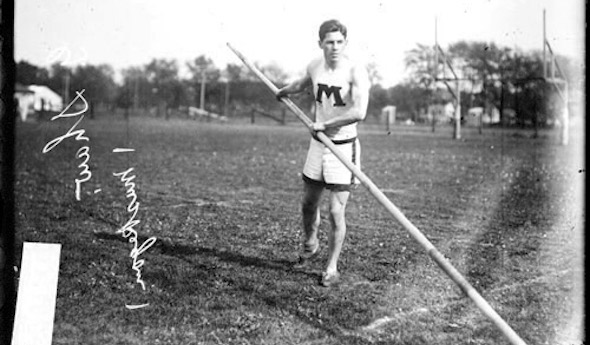
Tales of Teams, Trophies & Trinkets
By
Ron Pesch
MHSAA historian
March 30, 2016
High school athletics leaves behind an amazing array of treasures – although while buried in a keepsake box, or trophy case, the awards stand silent.
For many, their meaning and worth only continues to grow in value. Yet, in other cases, time can be cruel. For some trophies and trinkets, their worth diminishes as the stories contained within are lost behind retirements, neglect, administration decisions and death.
Following are a few tales that live on from more than a century of Michigan high school sports.
|
1909 |
Muskegon High School |
Track Trophy |
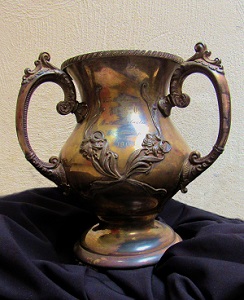 The search continues for the oldest state title trophy presented to a high school in the state of Michigan. This beauty, on display at Muskegon High School within the school’s storied trophy cases, currently leads the pack. In 1909, Muskegon coach Robert Zuppke’s team tallied 43½ points to win the fourth annual Michigan Agricultural College Interscholastic meet in Lansing. The total was the largest sum in the history of the meet, exceeding Detroit University School’s total of 27½ points and Detroit Central’s third-place total of 25 points.
The search continues for the oldest state title trophy presented to a high school in the state of Michigan. This beauty, on display at Muskegon High School within the school’s storied trophy cases, currently leads the pack. In 1909, Muskegon coach Robert Zuppke’s team tallied 43½ points to win the fourth annual Michigan Agricultural College Interscholastic meet in Lansing. The total was the largest sum in the history of the meet, exceeding Detroit University School’s total of 27½ points and Detroit Central’s third-place total of 25 points.
Dominant in the field events, Muskegon was led by George Shaw, who set a new record in the pole vault at 11 feet, 2 inches, and by George Cowley, whose 4:47 time in the mile also set a new mark. Cowley’s time in the mile ranked among the top in the middle west.
Zuppke moved on a year later to coach at Oak Park, Ill., then to the University of Illinois where he became known as one of the great coaching minds in the history of college football. Shaw would school at Northwestern University while Cowley spent some time at the University of Chicago following graduation.
|
1923 |
Dollar Bay |
2nd U.P. Class B Tournament |
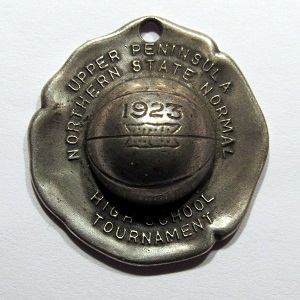 Someone within the Dollar Bay roster was once the proud owner of this silver basketball fob, given to team members by Northern Michigan Normal College for finishing second in the 6th annual Class B High School Basketball Tournament hosted at Northern State Normal College. According to documentation on the event, six sessions were held, and during presentation of the awards, only seven fobs were awarded to each of the top three teams. As was quite common at the time, only last names of players were mentioned in the game program and newspaper coverage. I guess back in the day, everyone who needed to know already knew the player’s first name.
Someone within the Dollar Bay roster was once the proud owner of this silver basketball fob, given to team members by Northern Michigan Normal College for finishing second in the 6th annual Class B High School Basketball Tournament hosted at Northern State Normal College. According to documentation on the event, six sessions were held, and during presentation of the awards, only seven fobs were awarded to each of the top three teams. As was quite common at the time, only last names of players were mentioned in the game program and newspaper coverage. I guess back in the day, everyone who needed to know already knew the player’s first name.
Purchased on Etsy, perhaps this medal was owned by Stevens, who played one of the guard spots and served as team captain. He was responsible for all nine of the team’s points in the Class B championship game. Perhaps it belonged to Penphrase or Mattson, who each scored four points in the semifinal round, where Dollar Bay trounced Stambaugh 21-12. Munising defeated Newberry 15-10 in the semifinal, setting the stage for the title game. Munising won the Saturday evening contest, 17-9, and earned the right to play the Class A winner for the “supremacy of the Upper Peninsula." One week later at the Normal Gym, Munising topped Escanaba, winner of the Class A tournament, for the honor.
|
1927 |
J. Perry Austin |
Three Oaks |
4:57.3 |
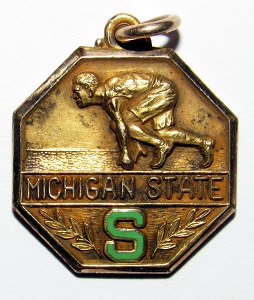 Along with his brother Phil, Joseph Perry Austin was one of 20 graduates in the class of 1927 at Three Oaks High School (Today known as Three Oaks River Valley). The most famous of the group was perhaps Joe Savoldi, who would star at Notre Dame.
Along with his brother Phil, Joseph Perry Austin was one of 20 graduates in the class of 1927 at Three Oaks High School (Today known as Three Oaks River Valley). The most famous of the group was perhaps Joe Savoldi, who would star at Notre Dame.
The Austin boys moved to Three Oaks from Waukegan, Ill, when they reached high school age. There, Perry, as he was known among family and friends, would excel athletically and academically, winning the Class C MHSAA state championship in the mile and serving as valedictorian of his class. Phil was salutatorian. This medal, presented at Michigan State College of Agriculture and Applied Science (now Michigan State University) was found on Ebay.
Following graduation, Perry attended the University of Michigan, where he was crowned Big Ten Champion in the two mile in 1931. That same year, Austin was honored by the Big Ten with the conference’s prestigious Medal of Honor, awarded one per sport, for athletic and academic achievement in Track & Field. He would remain at Michigan, earning a doctorate in chemistry in 1935.
After graduation, he worked for Abbot Labs in Chicago. In the 1940s, Austin joined the seminary and became an Episcopalian priest, serving parishes in Wisconsin, Texas and Michigan. Ultimately, he returned to education, teaching high school chemistry in Toledo, Ohio. He passed away in 1991.
His brother Phil would ultimately become an internationally renowned watercolorist and a member of the exclusive American Water Color Society.
|
1940 |
Merrill Vandals scoreboard |
Castle Museum, Saginaw |
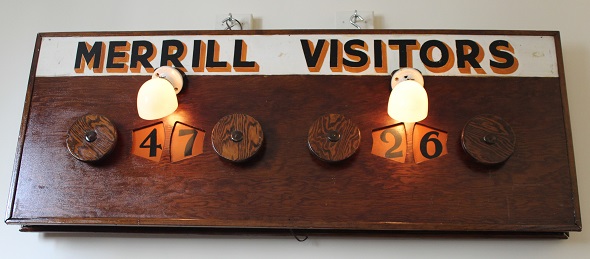 As the story goes, Merrill High School students built this scoreboard in shop class sometime during the late 1930s for use in their high school gymnasium. The board served the district for approximately the next 50 years. “It was always an honor to be selected as one of the kids to operate the scoreboard,” recalled Keith Clark, a former Merrill student who in later years served as a coach, then administrator in the district. “One kid would operate the home side and the other would operate the away side.”
As the story goes, Merrill High School students built this scoreboard in shop class sometime during the late 1930s for use in their high school gymnasium. The board served the district for approximately the next 50 years. “It was always an honor to be selected as one of the kids to operate the scoreboard,” recalled Keith Clark, a former Merrill student who in later years served as a coach, then administrator in the district. “One kid would operate the home side and the other would operate the away side.”
When the new high school opened in 1956, the scoreboard remained in place at the building where it served junior high school teams until the 1980s. It was ultimately presented to Walt Krause, a longtime employee of the Merrill school district. Thanks to the efforts of Clark, and the kindness of the Krause family, the board eventually made its way to the Saginaw Sports Hall of Fame with a single stipulation – that the score displayed should always show Merrill leading.
|
1947 |
Brethren Dickson |
Basketball Team |
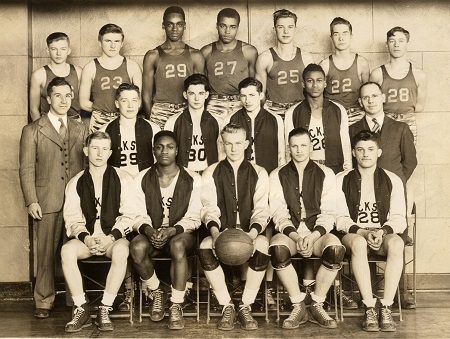 A scan of a photo cherished by the son of one of the team members, this team picture would likely go unnoticed mixed in with a stack of others. Yet, standing in the back row, wearing number 27, is an individual with a likeness, and most certainly a voice, that would be recognized by tens of millions. The Brethren Dickson basketball team of 1947 was eliminated early in the tournament. The 1932 team finished the year as runner-up to Portage for the Lower Peninsula’s Class D title. In 1963, Brethren lost in the state semifinals to eventual Class D state champion Britton.
A scan of a photo cherished by the son of one of the team members, this team picture would likely go unnoticed mixed in with a stack of others. Yet, standing in the back row, wearing number 27, is an individual with a likeness, and most certainly a voice, that would be recognized by tens of millions. The Brethren Dickson basketball team of 1947 was eliminated early in the tournament. The 1932 team finished the year as runner-up to Portage for the Lower Peninsula’s Class D title. In 1963, Brethren lost in the state semifinals to eventual Class D state champion Britton.
Using his full given name, one can argue that James Earl Jones ranks with Earvin “Magic” Johnson as the state’s most famous basketball player, though his fame is for something entirely different than his ability to shoot a basketball.
|
1967 |
Ann Arbor University High School |
Track Trophy |
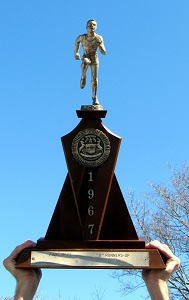 Found at a thrift store in Ann Arbor, it was purchased for $2.12, tax included. Showing its age, the trophy was earned by Ann Arbor University High’s track team that finished second to Detroit St. Charles.
Found at a thrift store in Ann Arbor, it was purchased for $2.12, tax included. Showing its age, the trophy was earned by Ann Arbor University High’s track team that finished second to Detroit St. Charles.
Ann Arbor University High was a demonstration school operated by the University of Michigan’s School of Education. In 1922, the State of Michigan legislature approved $525,000 for the construction and furnishing of the building near the campus of the university. In the fall of 1924, the school was opened with 123 students in grades 7-12. In 1930, an elementary school was added. According to U-M’s Bentley Historical Library, “the school was used as a demonstration center for educators in the newer practices of educating children.”
University High’s athletic teams were nicknamed the Cubs, an obvious nod to the University of Michigan’s Wolverines. University High continued to operate into the 1960s, when a decision was made by U-M’s School of Education to close the school.
The 1967 team, led by Dave Shipman, finished second to Detroit St. Charles in point total, 64 to 47. Shipman, an individual winner in both the 100 and 220-yard events, also ran on University’s victorious 880 relay team. A year later, the final senior class graduated from the school.
|
1984 |
Brimley High School |
Volleyball |
 This medal dates to the days when champions were crowned in volleyball in both upper and lower peninsulas of Michigan. (In the year 2000, the tournament was unified.) This is another Ebay find.
This medal dates to the days when champions were crowned in volleyball in both upper and lower peninsulas of Michigan. (In the year 2000, the tournament was unified.) This is another Ebay find.
Between 1980 and 1990 the U.P. staged a single open tournament for all schools north of the Mackinac Bridge. Despite competing against schools with much larger enrollment, the Brimley Bays captured seven titles during those 11 years of competition. Located just off I-75, coach Charles Compo’s team traveled extensively into the Lower Peninsula to gain experience. The time and travel paid dividends as the team captured five straight titles between 1981 and 1985. The 1984 title came with 15-3, 15-11 wins over Bessemer. That season, Compo was named U.P. Coach of the Year.
“Compo retired in 1990 with an amazing record of 408 victories and only 74 losses,” notes the Upper Peninsula Sports Hall of Fame, recognizing the achievements of those squads. “Seventeen of Compo's players would earn all-state honors, a total of 32 times.”
|
2009 |
Allison Pall |
East Grand Rapids |
1:50:09 |
 “When the boys on the football team got whiny about practice, their coach would bring them to one of our practices,” remembered Allison Pall, discussing the hours spent training before earning this medal as a member of the East Grand Rapids 200 medley relay team. Those practices were run by legendary swimming coach Milton “Butch” Briggs, Jr. Since taking on the task in fall of 1975, Briggs has led the girls to 19 MHSAA championships and the boys to 10 titles.
“When the boys on the football team got whiny about practice, their coach would bring them to one of our practices,” remembered Allison Pall, discussing the hours spent training before earning this medal as a member of the East Grand Rapids 200 medley relay team. Those practices were run by legendary swimming coach Milton “Butch” Briggs, Jr. Since taking on the task in fall of 1975, Briggs has led the girls to 19 MHSAA championships and the boys to 10 titles.
Pall, along with schoolmates Ally Bremer, Molly Lundquist, and Karly Surman won the 200 medley relay with an MHSAA Finals time of 1:50.09 at Eastern Michigan. A year later Pall, Bremer, Emily Lundquist and Katie Lachance again won the 200 medley relay, at 1:48.82 at Holland Aquatic Center. The girls clocked a 1:48:75 in the prelims the day prior, establishing a then-school record.
A late beginner in the sport, Pall took up competitive swimming in seventh grade. Following high school graduation, Pall headed to Ann Arbor to enroll at the University of Michigan, where she left behind her swimming career. Her height, an advantage in swimming, meant she was recruited to join the University Rowing team. She stayed for a season, deciding to dedicate herself to studies. Today, Allison is in pursuit of her Master’s degree in Public Health. Her medals will not be found for sale online. They still mean the world to her.
 Ron Pesch has taken an active role in researching the history of MHSAA events since 1985 and began writing for MHSAA Finals programs in 1986, adding additional features and "flashbacks" in 1992. He inherited the title of MHSAA historian from the late Dick Kishpaugh following the 1993-94 school year, and resides in Muskegon. Contact him at [email protected] with ideas for historical articles.
Ron Pesch has taken an active role in researching the history of MHSAA events since 1985 and began writing for MHSAA Finals programs in 1986, adding additional features and "flashbacks" in 1992. He inherited the title of MHSAA historian from the late Dick Kishpaugh following the 1993-94 school year, and resides in Muskegon. Contact him at [email protected] with ideas for historical articles.
PHOTO: George Shaw prepares for the pole vault for Muskegon High in 1909. (Photos gathered by Ron Pesch.)
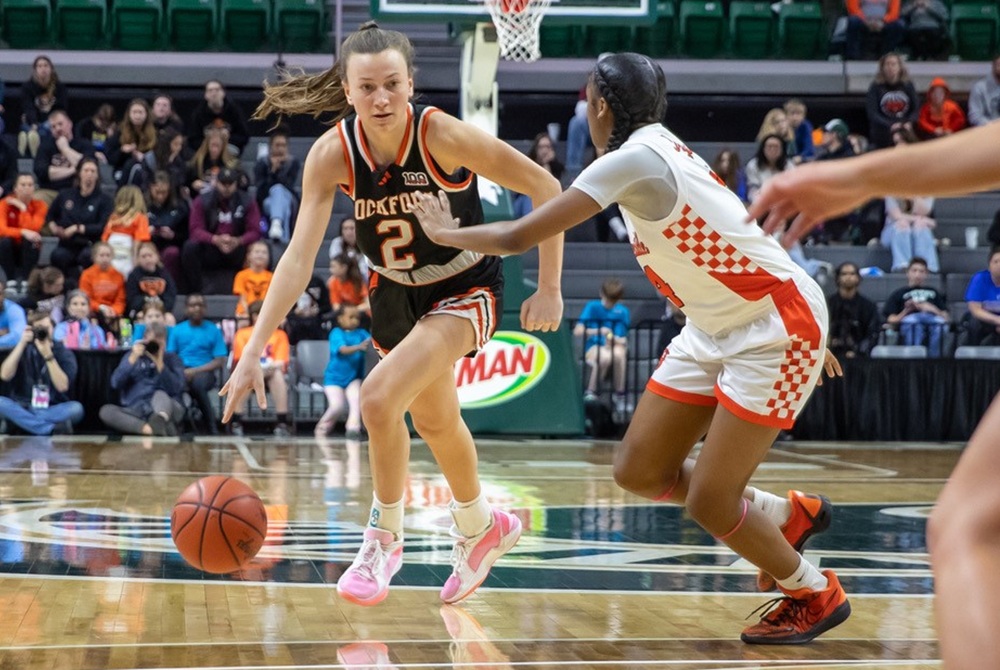
Rockford's Miss Basketball Caps Career Among State's Top Shooters, All-Time Winners
By
Geoff Kimmerly
MHSAA.com senior editor
December 19, 2025
Rockford’s Anna Wypych finished her high school career in March with four record book listings earned during her four-year varsity career and Miss Basketball Award-winning senior season.
She made 94 3-pointers last winter, good for fifth all-time, and finished her career with 203. She also made the career games played list with 107 and career wins list helping the Rams to a 99-8 record. Rockford won the Division 1 championship in 2023, finished runner-up last winter and also made the Semifinals when Wypych was a freshman and junior.
She’s continuing her career this season at Butler.
See below for several recently-added listings to the girls basketball record book, and click the heading to see the record book in full. Several more applications have been received and are in the process of being confirmed.
Girls Basketball
Mia McGregor is up to 26 listings in the record book after her first two seasons at Mio. Her 58 points in a game against St. Helen Charlton Heston as a freshman is tied for ninth and one of her 12 games scoring 45 or more points. Her 866 points (41.2 ppg average) that debut season rank second all-time, and she’s already on the career 3-pointers (160) and free throw (345) lists. She also made the single-game assists list with 14 against Atlanta last season.
Jaxi Long’s heroics at the end of a 61-54 win over Muskegon Western Michigan Christian on Jan. 4, 2022, have her second on a record book list. She scored 29 points, including 22 in the fourth quarter, as Newaygo came back from an 11-point deficit that period. She’s playing at Cornerstone.
Baraga senior Kara Roberts made the single-season 3-pointers list as both a sophomore (74) and junior (70). Baraga as a team also made multiple 3-pointer lists over the last few seasons, including with 13 in a game last winter. Roberts has committed to continue at Wisconsin-Eau Claire.
Morrice’s Aubrey Rogers totaled 20 steals during a Feb. 2, 2024, win over Burton Bendle, tying for second-most in one game. She was a senior and has continued at Spring Arbor.
Ishpeming’s march to the Division 4 championship in 2024 includes several record-book accomplishments as a team and individually. As a team, Ishpeming tied the single-season record of 28 wins in finishing 28-1, and made lists with 195 3-pointers and 710 attempts from beyond the arc. Then-junior Jenessa Eagle made the record book with 72 of those 3-pointers. She has signed with Michigan Tech.
Evart junior Kyrah Gray made the single-season steals list with 15 in a Dec. 6, 2024, game against Beal City, and finished the season with 188 over 25 games – the season total ranking fifth all-time.
Averie Zinn has entered her senior season at Genesee with 20 record book listings – and a chance to add several more. Zinn’s best from her first three seasons included 851 points scored (32.7 per game) last winter, which rank third all-time; 186 free throws last season, which rank 10th; and 218 steals also from last season that rank third on that list. She has committed to Wayne State.
Charlotte senior Peyton Howarth cemented her name in the record book with nine 3-pointers in a Dec. 7, 2024, game against Quincy. She finished with 29 points.
Vivian Idziak earned Grand Rapids Union’s first record book entry in this sport with 15 blocked shots against Muskegon Reeths-Puffer on Jan. 16, 2024, and added a second with 27 rebounds against Wyoming Kelloggsville this past Feb. 25. She graduated this spring and will continue at Grand Rapids Community College, where she will run cross country.
Braxcynn Baker finished her Lowell career in 2024 with several record book listings, including for 183 free throws (in 223 attempts) as a senior and 479 free throws (ranking eighth) in 587 attempts with an .816 percentage for her career. She also made the career 3-pointers list with 180 over 91 games. Her senior-season free throws contributed significantly to Lowell’s MHSAA-record 319 over 25 games that season. She’s continuing her career at Murray State.
Orchard Lake St. Mary’s earned its first girls basketball record book listings during the 2023-24 season. As a team, the Eaglets made 171 3-pointers in 487 attempts – both totals making lists – and Allie Crighton made the single-season free-throw shooting list by connecting on 87 percent of her attempts. She’s a junior and has committed to Northwood.
Fallon Behrick launched a quick start on her 32-point night for Otisville-LakeVille Memorial against Mt. Morris on Jan. 23. The senior scored 21 first-quarter points to make the single-quarter scoring list.
Milan’s Emily Bladen scored 39 points on Dec. 10, 2024, against Britton Deerfield, with 27 coming on nine 3-pointers as she made that single-game list. She’s currently a junior.
Parc Liggins also earned a spot on the single-game 3-pointers list with 10 in 14 attempts for Grand Blanc against Lapeer on Jan. 24. She’s a senior this winter.
Parchment’s 61-30 win over Delton Kellogg on Jan. 28 saw the winning team tie for the sixth-most 3-pointers made in one game – 17 – while also making the single-game attempts list with 47.
Adelyn Moore finished her career at Caro in 2023 by making single-season lists with 150 steals and 336 rebounds – and also career lists with 442 steals and 1,047 rebounds over four seasons and 80 games. She played a season at University of Chicago and is now at Denison in Ohio.
Kent City added to its growing list of top 3-point performances when it connected on 16 – on only 37 attempts – in a Feb. 11 game against Howard City Tri County.
White Cloud’s Alexis Strait tied for the fourth-most 3-pointers in a game when she made 11 on the way to scoring 37 points total on Feb. 7, 2020, against Hesperia. She was a junior that season.
Tamerah Peterson capped her Sterling Heights Parkway Christian career last winter with 633 steals – good for second on the career list – over four seasons and 86 games. Her 213 steals as a sophomore rank fourth for a single season. She was joined in the records by now-junior Angelina Marchesi, who made the single-season rebounds list with 312 over 24 games. Peterson is running track at Spring Arbor.
Merrill’s Maddy Desmyter entered her senior season with a record book entry after grabbing 316 rebounds over 23 games last winter. She has committed to Adrian College.
Twice over five days in February, Analeis Ming made the single-season assists list with two of the highest-ranking performances in state history. She had 15 assists in Au Gres-Sims’ game Feb. 13 against Atlanta and 17 steals on Feb. 17 against Fairview. She is a senior and has committed to play soccer at Knox College in Illinois.
Jayna Schwartz capped her Battle Creek Calhoun Christian career last winter with 73 3-pointers over 21 games, making that single-season list. She just missed the single-season list as a junior with 64.
Madeline Pier tied for 13th all-time on the single-game rebounds list when she grabbed 30 in Swartz Creek’s win over Flint Kearsley on Jan. 31. She’s a junior.
Saline’s Keira Roehm drained 100 3-pointers last winter – third-most in MHSAA history – and had 238 entering her senior year to already rank 12th on the career list after 73 games. She contributed significantly to Saline’s team total of 174 over 24 games. She’s committed to Wayne State.
Hanna Vaughn added 46 more 3-pointers as a senior last season to finish her four-year Ironwood career with 201 over 92 games. She’s playing volleyball and basketball at Gogebic Community College.
Nearly 50 years later, the longest overtime game in MHSAA girls basketball history has been uncovered. Michigan Center defeated Grass Lake 57-50 in six overtimes on Oct. 11, 1978. Coincidentally, Michigan Center also played in a five-overtime game that was tied for the record before this result was added to the top of the list.
Niles Brandywine added to its several listings for 3-pointers attempted and made, connecting on 198 of 689 attempts over 28 games last season. Both rank among the top 15 in their respective categories.
Victoria Hauffe has entered her senior season at Hemlock already on the career 3-pointers list with 159 over her first three seasons and after connecting on 69 last winter. Hemlock as a team was added to the records for making 13 3-pointers against Essexville Garber last December and attempting 529 over 25 games.
Dena Droste played four varsity seasons for DeWitt through graduation in 2011, and finished on the career 3-pointers list with 152 in 415 attempts. She went on to play at Kent State and Ferris State.
PHOTO Rockford's Anna Wypych (2) makes a move toward the lane during last season's Division 1 championship game.

